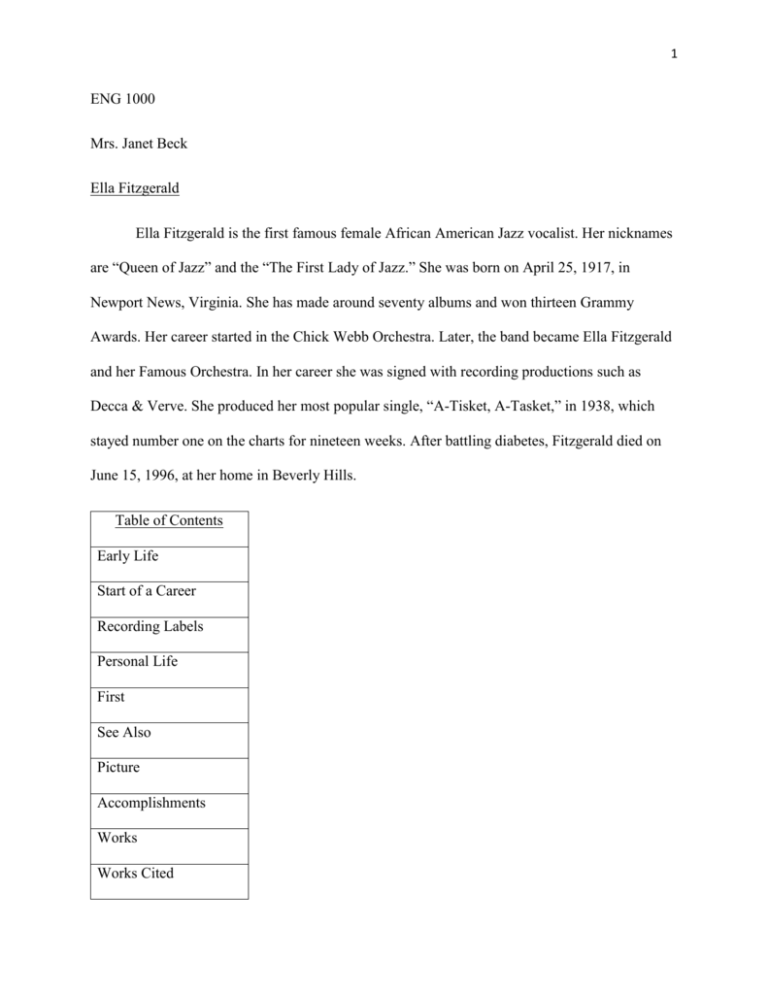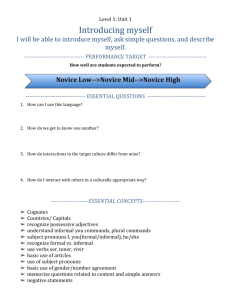Ella Fitzgerald Research Paper
advertisement

1 ENG 1000 Mrs. Janet Beck Ella Fitzgerald Ella Fitzgerald is the first famous female African American Jazz vocalist. Her nicknames are “Queen of Jazz” and the “The First Lady of Jazz.” She was born on April 25, 1917, in Newport News, Virginia. She has made around seventy albums and won thirteen Grammy Awards. Her career started in the Chick Webb Orchestra. Later, the band became Ella Fitzgerald and her Famous Orchestra. In her career she was signed with recording productions such as Decca & Verve. She produced her most popular single, “A-Tisket, A-Tasket,” in 1938, which stayed number one on the charts for nineteen weeks. After battling diabetes, Fitzgerald died on June 15, 1996, at her home in Beverly Hills. Table of Contents Early Life Start of a Career Recording Labels Personal Life First See Also Picture Accomplishments Works Works Cited 2 Early Life Ella Jane Fitzgerald was born on Wednesday, April 25, 1917, in Newport News, Virginia. Her unmarried parents were William Fitzgerald and Temperance “Tempie” Williams Fitzgerald. Ella, growing up, had a hard life. By the time she was around three years old, Ella’s father walked out of the picture. At this point Tempie found a new man named Joseph “Joe” Da Silva, an immigrant from Portugal. According to Nicholson, the family decided to move to Yonkers, New York with news of “better employment and housing prospects in the northern urban centers” (4). These rumors were discovered false when Tempie and Joe both could not find jobs and had to move into a one bedroom residence (4). In 1923, Tempie became pregnant with Ella’s half-sister, Frances. During this time, Ella grew a passion for dancing. According to Nicholson, Ella and her friends would “sneak off to the Savoy Ballroom in Harlem to pick up the latest steps” (13). All this grew to a halt when Ella’s mother, Tempie, died of a heart attack unexpectedly in 1932, leaving Ella and Frances alone with their step-father Joe. There were many rumors about Ella being mistreated by Joe, but she never talked about it. The news got to Tempie’s sister, Virginia, and she immediately moved Ella to her house in Harlem. Frances eventually moved in with their Aunt Virginia when Joe died from a heart attack. Ella dropped out of school and started participating in illegal work for the Mafia. When arrested, Ella was sent to the New York State Training School for Girls at Hudson. According to a study published in The Ella Fitzgerald Companion about the reformatory, “black girls… were segregated… and were routinely beaten by male staff” (David 9). As a result, Ella ran away to a part of New York known as “Black Broadway.” Start of a Career 3 Ella, now homeless, tried to make a living off tips received from performing dance numbers on the streets. She decides to make her first formal debut at the Apollo Theater during Amateur Night. She fully intended to audition as a dancer, but immediately became intimidated by the Edward Sisters. According to Nicholson, Ella was overwhelmed by their “professional appearance… [and] dancing ability” (18). In that moment Ella changed her talent to singing and performed “Object of My Affection” and “Judy.” That night Ella won Amateur Night competition, and as a reward would go on to perform for a whole week at the Harlem Opera House in New York (Fritts 4). News got around to Charles Liton about this young female Jazz vocalist. During this time, Chick Webb from the Chick Webb Orchestra was looking for a female singer to join his band. When Liton first brought Ella to Chick, he refused to have her perform with the band due to her appearance. It was obvious Ella had not taken a shower in weeks and no suitable clothing for herself, but after listening to her sing, and given proper clothing, Ella joined the Chick Webb Orchestra (Nicholson 34-36). Recording Labels During this time, Ella signed with Decca Records, and she would go on to sell over 22 million records. Ella’s first recording with the Chick Webb Orchestra under Decca Records was “I’ll Chase the Blues Away” and “Love and Kisses.” While performing for the Chick Webb Orchestra, the band focused on centering Ella as the main attraction. According to Nicholson, doing this would play a “vital role in establishing [Ella’s] early popularity” (48). On May 2, 1938, Ella records “A-Tisket, A-Tasket,” under Decca Records, imitating an old nursery rhyme. The song reached number one on the charts, and “stayed on the hit parade for a total of nineteen weeks” (54). After Chick died in 1939, Ella took over the band which was renamed Ella Fitzgerald and Her Famous Band. The band broke up after about three years, and Ella began her 4 solo career accompanied with The Four Keys. In 1956, Ella would leave Decca Records “to join [Norman] Granz’s newly founded Verve label” (J. Bradford Robinson). Granz asked Ella to perform with the Jazz at the Philharmonic tour in the United States. When this became a huge success, they toured Europe (1952) and Japan (1953), “both of which were immensely successful” (Shadwick, Keith). Even though she had many accomplishments with Decca, Ella also achieved great things under Verve Records. For example, under Verve, Ella created her Song Book series. This consisted of a series of covers from famous American artists which “[established] Fitzgerald among the supreme interpreters of the popular-son repertory” (Robinson, J. Bradford). She would go on to record a live album at the Opera House with Louis Armstrong, and performed at President John F. Kennedy’s Inaugural Gala (Shadwick, Keith). Personal Life Ella always looked for means of receiving affection, whether it be from the audience or from lovers. When Ella met Benny Kornegay, she became smitten, fell in love, and married him December 26, 1941. Their marriage did not go public immediately, and it was not successful. According to Gourse, “Ella’s mind was more on music than ménage” (104). Eventually, their marriage would be annulled. After some investigations, it was found that Kornegay was a previous drug dealer who had served some time. According to Nicholson, it also seemed suspicious that “[Kornegay] was becoming increasingly assertive and insisting on greater involvement in his wife’s career” (68). Ella married once more to a man named Ray Brown, a bassist, in 1947. They met while traveling with Dizzy Gillespie’s band. While married, the couple had Ray Brown Jr. in 1950. The marriage slowly fell apart as a result of constant separation while traveling, and they divorced August 28, 1953, leaving Ella with custody of Ray Jr. 5 First Ella Jane Fitzgerald was the first famous female African American Jazz vocalist. In 1939, Ella became the leader for her own orchestra named Ella and Her Famous Orchestra. Along with Count Basie in the same year, she was one of the first African Americans to win a Grammy in 1959. Ella broke many color barriers by hitting the top one hundred charts with over twenty five singles. “A-Tisket, A-Tasket” hitting number one for nineteen weeks. Ella Fitzgerald is known as a major influence in the music industry. Coming from an abusive, poor, and prejudice background, Ella was able to conquer all obstacles to become the first famous female African American Jazz vocalist. See Also Chick Webb Orchestra Ray Brown Ray Brown Jr. Decca Records Verve Records Norman Granz Charles Liton 6 Picture Photo by Michael Ochs Archives/Getty Images Accomplishments 13 Grammy Awards Grammy Lifetime Achievement Award- 1967 Kennedy Center Honor Award-1979 National Medal of Arts Award- 1986 Society of Singers Award- 1989 Presidential Medal of Freedom Award- 1992 George and Ira Gershwin Award- 1989 Works Ella recorded around 70 albums in her lifetime. Here is the list of the thirteen albums that won Grammy Awards: Ella Fitzgerald Sings the Duke Ellington Songbook- 1958 7 Ella Fitzgerald Sings the Irving Berlin Songbook- 1958 “But Not for Me”- From Ella Fitzgerald Sings the George and Ira Gershwin Songbook1959 Ella Swings Lightly- 1959 Ella in Berlin: Mack the Knife- 1960 Ella Swings Brightly with Nelson- 1962 Fitzgerald and Pass… Again- 1976 Fine and Mellow- 1979 A Perfect Match- 1980 Digital III at Montreux- 1981 The Best Is Yet to Come- 1983 All That Jazz- 1990 The Complete Ella Fitzgerald Songbooks- 1995 8 Works Cited Fritts, Ron, and Ken Vail. Ella Fitzgerald: The Chick Webb Years & Beyond. Lanham: Scarecrow, 2003. Print. Nicholson, Stuart. Ella Fitzgerald: The Complete Biography. London: Routledge, 2004. Print. David, Norman. The Ella Fitzgerald Companion. Westport: Praeger, 2004. Print. Gourse, Leslie. The Ella Fitzgerald Companion: Seven Decades of Commentary. New York: Schirmer, 1998. Print. Shadwick, Keith. "Ella Fitzgerald: The First Lady of Song." Music Week 16 (2007): 1518. Music Index. Web. 22 Nov. 2014. Robinson, J. Bradford. "Fitzgerald, Ella." Grove Music Online. Oxford Music Online. Oxford University Press. Web. 23 Nov. 2014.







